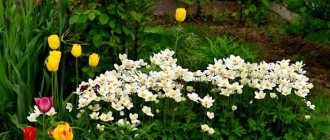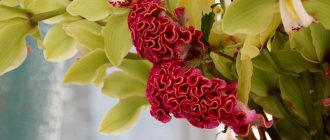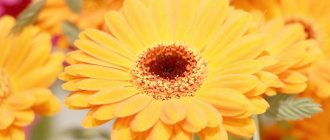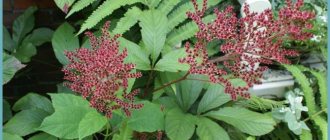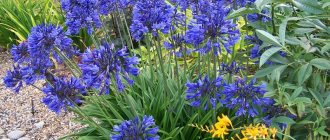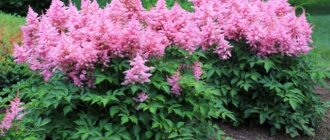Anemone De Caen is one of the varieties of crown anemone. This varietal group is characterized by beautiful flowers, a pleasant aroma and increased frost resistance. These qualities have contributed to its wide distribution among amateur flower growers and landscape designers. But in order to achieve a highly decorative plant, it is necessary to follow certain rules for planting and further care.
Good growth of anemone "De Caen" depends on the quality of the soil
Description and characteristics
Crown anemone "De Caen" belongs to the category of herbaceous plants for open ground. She is a representative of the Ranunculaceae family. The height of the perennial is about 30 cm. Most of the petiolate leaves are located at the bottom of the plant, forming a basal rosette. The plates are pinnately dissected. The stems are erect, simple, with a small edge on the surface. The shoots also have sessile leaves, which are arranged alternately.
Anemone "De Caen" belongs to the non-double varieties of the crop. Each shoot of the plant bears one bud. Their diameter when opened reaches 8-10 cm. The shape of the flowers is saucer-shaped, with flat petals along the edge. Anemone "De Caen", as seen in the photo, has a bright color of flowers. Moreover, in this variety series there are both single-color and two-color varieties.
The central part of the anemone flowers is very large, convex in shape. It can have several shades. In the middle there is a large pistil, framed by numerous stamens. The De Caen variety blooms twice per season. The first time is abundant in the spring, and the second time in early autumn. The root system of the crown anemone is represented by a tuber, which contains a supply of nutritional components.
Important! This culture is characterized by a short life cycle.
The anemone's growing season begins in early spring, and after flowering the above-ground part dies off completely. The tuber contains restoration buds, the formation of which occurs in the late spring period preceding flowering. With the arrival of autumn, the growing season resumes and the perennial blooms again, but not so abundantly. At the end of October, the above-ground part of the perennial dies again, but the dormant period lasts until spring.
Anemone "De Caen" - a short-day plant
Conclusion
Anemone is a completely easy-to-care flower, which, nevertheless, has several advantages that determine its popularity. Anemones are extremely diverse (160 varieties), they can easily decorate any flower bed, and are well adapted to the temperate climate of Russia.
In a word, caring for Anemone is pleasant and easy. For this reason, it is perfect for not the most experienced summer residents. On the other hand, excellent appearance and truly inexhaustible possibilities for creating a unique design in the garden are excellent characteristics for avid gardeners.
Variety varieties
The most commonly sold mixture is crown anemone “De Caen”. But this varietal group includes many different species. Therefore, if you wish, you can purchase planting material of a certain variety if you contact large gardening centers. Anemone tubers do not have high germination rates, and if the rules for their storage are violated, they become unsuitable for planting.
Important! You need to purchase planting material for the De Caen anemone from trusted manufacturers, and you should pay attention to the deadline for sale.
De Caen Bicolor
A spectacular variety of crown anemone, the highlight of which is a wide scarlet ring running across the white petals. The height of the De Caen Bicolor bush does not exceed 30 cm. The foliage is of a standard size, pinnately dissected. The diameter of the buds when fully opened barely reaches 8 cm.
Read more Planting and caring for anemones in autumn
Crown anemone "Bicolor" is one of the most frost-resistant varieties
De Caen La Sylphide
This species is distinguished by pale lilac petals and dark purple stamens. The height of the bushes does not exceed 30 cm. The color of the flowers of the anemone “De Caen Sylphide” can vary depending on the time of day and the composition of the soil. The diameter of the opened buds of this variety reaches 7 cm.
"Sylphide" is characterized by abundant flowering
De Caen Bride
This crown anemone has snow-white petals and sandy stamens. The height of the bushes of the De Caen Bride variety barely reaches 25 cm. This species does not tolerate direct sunlight, so the best option for it may be a lacy shade from closely planted trees and shrubs. The diameter of the flowers is 6-7 cm.
Direct sunlight deteriorates the decorative effect of the Bride anemone
De Caen Holland
This variety is one of the most spectacular. The main color of its petals is bright scarlet, but closer to the center there is a white contrasting ring framing the black stamens. Crown anemone "De Caen Hollandia" (De Caen Hollandia) is characterized by increased resistance to adverse weather conditions and diseases. The height of the bushes is 20-25 cm.
"Holland" retains freshness for a long time when cut
De Caen Mr. Fokker
This variety of crown anemone has a rich blue tint to its petals and stamens. Depending on the soil and fertilizing, a purple tint may be present. The height of the bushes of the De Caen Mr. Fokker variety reaches 30 cm. The diameter of the opened buds is 8 cm.
The variety of anemone "Mr. Fokker" is most decorative when planted in partial shade
What is anemone forcing and how to do it by March 8?
Anemone is the same plant that can bloom at any time of the year. The main thing is to comply with all the necessary conditions.
For example, in order for Anemone to please with bright and developed inflorescences by March 8, its tubers should be planted around December-January. At the same time, you can plant already grown seedlings. If you give preference to seed planting, it will take about a year for a normal plant to form that can bloom.
It is important to maintain a low room temperature throughout the growth period. The best option is +12-15 Co. In addition, it is important not to forget that with a lack of light, especially in winter, Anemone does not develop, but freezes. If you don’t notice this in time, it’s easy to flood the flower and ruin it.
Advantages and disadvantages of the variety
The De Caen variety series has a number of advantages, which allows it to stand out noticeably against the background of other types of crops. But she also has her own weaknesses that need to be paid attention to. This will allow you to compare the characteristics of different varieties of anemone and make a final decision.
Anemone "De Caen" is considered a medium-sized crop species
Main advantages:
- variety of colors;
- high decorative qualities;
- suitable for cutting;
- increased frost resistance;
- large size flowers;
- undemanding to care.
Disadvantages of crown anemone "De Caen":
- short life cycle;
- in the northern regions you need to dig it up for the winter;
- tubers do not germinate well after long-term storage;
- requires fertile soil;
- does not tolerate waterlogging.
Features of cultivation
There are a large number of species and varieties of anemone, some of which are unpretentious to growing conditions, while others, on the contrary, require special care. The thing is that some species are tuberous, while others are rhizomatous. It is the rhizomatous species that are distinguished by their unpretentiousness and ease of care, while the tuberous ones can suffer greatly if they are not cared for correctly. There are several features of growing such a flower that you need to know:
- In dry and very hot weather, they must be watered.
- In autumn, flowers should be fed with complex mineral fertilizers, and before planting and during active growth or flowering, organic matter should be added to the soil.
- To prevent plants from freezing, they should be covered with a layer of fallen leaves in winter.
- The easiest way to propagate this plant is by seeds, which are sown before winter, or by root shoots in spring.
How to grow anemones and ranunculus. Website "Garden World"
Reproduction methods
As the anemone grows, its root tuber enlarges and subsequently becomes overgrown with daughter bulbs. This allows you to propagate the variety you like. To do this, you need to dig up the bush in the fall after flowering, clear it of soil and carefully disassemble the rhizome into “divisions.” After this, sprinkle all fresh wounds with wood ash and plant the daughter bulbs in a permanent place so that they have time to take root before frost.
Important! When digging up a crown anemone for the winter, you need to divide the root tuber in the spring immediately when planting.
The seed propagation method is not suitable for the De Caen variety series, since it is a hybrid form of the crop. Therefore, grown seedlings do not have species properties.
Common mistakes
It can be noted that it is very difficult to make a mistake when growing Anemone. This is a truly unpretentious and very persistent flower. In many ways, it grows completely on its own.
Therefore, the main problems are often associated with trying too hard. The easiest way to spoil Anemone is to water it more than normal. Almost always, the moisture it receives from dew and rain is enough for it.
Quite often, Anemone is dug up every time for the winter. Although in mild winters it is enough to simply cover the flowerbed with leaves and greenery from the harvest.
Finally, do not forget that Anemones are quite whimsical in terms of temperature, preferring coolness and a fresh breeze. On the contrary, too sunny and open areas will adversely affect the growth of this plant.
When to plant Anemone De Caen
Planting of the crown anemone "De Caen" in the fall should be carried out in the southern regions. The optimal period for this is the second half of September. This will allow the plant to fully take root and grow with the arrival of spring.
This variety series can also be used for forcing by a certain date. In this case, you should plant the De Caen anemone tubers in January or February, and then grow them in a warm room.
Read more Oak anemone (anemone): planting and care, photo
When to plant De Caen anemone tubers in spring
This variety series should be planted in the spring in the central and northern regions. This must be done when the soil has warmed up sufficiently to a depth of 20 cm and the threat of return frosts has passed.
Important! When planted in spring, the first flowering occurs in mid-July, and the second in late autumn.
How to care after flowering?
Typically, Anemone can fully bloom from April to October or even November. But much, of course, depends on the variety and care.
When the Anemone fades, before the first frost it is recommended to treat and hill up the area, covering the bushes well with soil. After the first frost, it is permissible to dig up the bush and separate the tuber from it. The above-ground part is discarded.
Advice: It is not at all recommended to dig up flowers at a time when the leaves on them are still green. This condition indicates that nutritional processes are still taking place in the tuber, and the plant is not ready for winter.
In regions with relatively mild winters, you can limit yourself to only cutting off the above-ground part of the bush and leaving the tubers in the winter. Light frosts will not harm the root system throughout the winter.
In some cases, it won’t hurt to cover the area with Anemone tubers with fallen leaves or removed tops from other garden crops. This will minimize the impact of sudden temperature changes throughout the cold season.
However, if winters in the region are characterized by severe frosts, then it is better to completely dig up the tubers, dry them and store them until future planting in the spring.
Dug up anemone tubers
Planting and caring for anemone De Caen mix
In order for this perennial to quickly adapt to a new place and bloom magnificently, you need to take into account the basic requirements of the culture. This is also confirmed by experienced flower growers who insist that when planting and caring for the crown anemone “de Caen” one should adhere to certain rules, otherwise it is unlikely that the desired decorative effect will be achieved.
Requirements for place and soil
This perennial prefers to grow in slightly shaded areas, protected from strong gusts of wind. It is preferable to choose places with a slight elevation, which will prevent moisture stagnation. Loams and sandy loam soil with a neutral acidity level are best suited for crown anemone "De Caen". In this case, the soil must have good moisture and air permeability. This perennial can be planted in heavy soil, but only after first adding sand and humus, which will make its structure more loose.
Important! The groundwater level in the area intended for the crown anemone "De Caen" must be at least 70 cm.
Tuber preparation
The tubers of the plant are not characterized by increased germination, so before planting they must be soaked in a solution of Epin or Zircon, which activates growth processes. In the absence of these drugs, you can use ordinary warm water. You need to immerse the tubers in it and leave until they swell. After this, they should be planted in a permanent place.
Tubers become slightly lethargic during long-term storage
How to plant Anemone De Caen flowers
When planting this perennial, it is necessary to correctly determine the growth point. After swelling, the recovery buds on the tubers should become clearly visible, which will simplify this task. The second guideline should be that the top always remains flat, so crown anemone “De Caen” should be planted with the pointed edge down.
The holes need to be prepared at a distance of 10 cm. Their depth should be about 15 cm. Humus and wood ash should be added to each planting hole, thoroughly mixing them with the ground. At the end of the procedure, the crown anemone “De Caen” needs to be watered generously.
Important! If it is still not possible to determine where the growth point is on the tuber, then it should be planted on its side.
The first shoots appear 2-3 weeks after planting
Aftercare
Growing and caring for the crown anemone "De Caen" does not require complex actions. Watering the plant should only be done during a long absence of rain. To do this, use distilled water. The frequency of moisturizing is 1-2 times a week. After each watering, you should loosen the soil at the base of the bush, which will improve air access to the roots.
Read more When to dig up anemones and how to store the bulbs
In case of prolonged drought, the root circle of the perennial should be mulched with humus or peat. This will retain moisture and prevent a crust from forming on the surface.
The crown anemone "De Caen" needs to be fed twice a season during the active growing season. To do this, you can use organic matter or nitroammophoska at the rate of 30 g per 10 liters of water. Also, during the flowering period, wood ash should be scattered near the bushes and then embedded in the top layer of soil.
When to dig and how to store
In the central and northern regions, the tubers of the crown anemone "De Caen" should be stored in a cool, dry room in winter. To do this, you should dig them up in October, when the above-ground part of the plant begins to fade. After this, dry and immerse in sand or peat. They should remain in this form until spring.
Flowering conditions
In general, Anemone begins to bloom quite early even without thorough care. Some varieties even bloom twice a year.
What you will need to especially watch out for is:
- So that the bushes are planted in partial shade. Too much sun can harm the plant. As well as the complete absence of sunlight - too.
- Do not overdry the soil near the bush. If necessary, water additionally as needed.
- Monitor the appearance of pests and remove them in a timely manner (remove them manually).
Otherwise, you can cope with care even without serious experience under your belt. So most of the planted Anemone bushes are sure to bloom.
Planting anemone De Caen with seeds
This perennial variety series can also be planted by seed. To do this, you should initially purchase high-quality planting material so that the end result does not disappoint.
Initially, you need to stratify the seeds of the crown anemone "De Caen". To do this, they should be wrapped in damp cotton cloth and placed in the bottom compartment of the refrigerator for 1.5-2 months. This procedure will significantly increase the germination and immunity of future seedlings.
Planting should be done at the end of February. To do this, you need to prepare wide bowls and fill them with nutrient substrate, adding 1 part of sand to it so that the water does not stagnate. Bury the seeds 0.5 cm into moist soil. After this, move it to a dark place with a temperature of +18-20 degrees. After friendly sprouts appear, which happens after 3-4 weeks, they need to be transferred to the windowsill.
When growing crown anemone "De Caen" from seeds, you should always keep the soil slightly moist. At stage 2 of real leaves, seedlings should be planted in separate containers. Planting can be done only when the soil warms up well, which happens in the second half of May.
Important! Crown anemone "De Caen", grown from seeds, blooms only in the third year.
Origin
Numerous legends composed about the flower by the ancient peoples of the Mediterranean express its presence and significance back in ancient times.
Despite the various variations of legends, the meaning of the flower and its appearance remains unchanged. The ancient Greek Goddess of love and beauty Aphrodite, struck by the grief of the loss of her beloved Adonis, mourned him for a long time at the place of death - her tears turned into scatterings of anemones.
Extraordinary tenderness and grace, the brightness of the color of the petals symbolize greatness and sorrow, chastity and trembling. Ancient girls decorated their heads with wreaths of anemones; they served as a talisman against evil spirits and misfortunes.
The mystery of the flower and its “unearthly” origin were reflected by ancient painters in their paintings with divine characters.
Christian biblical legends say that numerous anemones grew on Calvary after the execution of Christ. The blood of Christ poured out the purple color of the petals. The new Christians, the Palestinians, used the trefoil anemone as a symbol of the Holy Trinity.
The lightness of the petals and the flexibility of the thin peduncle, set in awe by the slightest vibration of the air, served as the second name of the flower “anemone” and the name of the genus, anemone translated from Greek means “daughter of the winds.”
The use of crown anemone in breeding dates back to 1600. Tubers brought to Europe from the countries of Asia Minor gained popularity in Italy, France, Germany, and Holland. Actively cultivated in North America. Modern breeding work in Russia is carried out at the Sochi Center.
Reference! Crown anemone belongs to the group of ephemeroids - perennial herbaceous plants that have the ability to go through all stages of growth in a short period of time: from the appearance of shoots to the ripening of seeds.
Pests and diseases
This perennial is highly resistant to diseases. Therefore, it does not require preventive treatment with fungicides. Of the pests, only slugs can cause damage to the crown anemone "De Caen" in conditions of high humidity. To combat them, sprinkle the root circle of the plant with wood ash or tobacco dust.
Slugs feed on the young leaves of the plant, sucking the juice from them
Medicinal properties
It both heals and cripples. Anemone is widely used in pharmacology due to a number of its medicinal properties, but at the same time, the flower is toxic and can contain poisons. Therefore, self-treatment is not recommended for them and specialist advice is required.
Main medicinal properties:
- Stops the growth of low-quality tumors;
- Anti-inflammatory and disinfecting effects;
- Strengthens blood vessels;
- Thins the blood;
- Effective in the fight against fungi.
Diseases of anemone flowers
Perennial anemone can delight your eye for many years. However, this is provided that she is not affected by disease. Let's see what this flower suffers from.
Anemone diseases:
- Nematodes;
- Aphid;
- Mining front sight;
- Slugs;
- Whitefly;
- Powdery mildew;
- Sclerotinia;
- Viral mosaic.
Each disease requires its own treatment. However, such problems often lead to plant death.
Anemone can make your garden something unusual and unique. The beauty and tenderness of its buds will more than compensate for the difficulty of planting this flower. Don't be afraid to experiment, and let your garden be the pride of the whole family!
